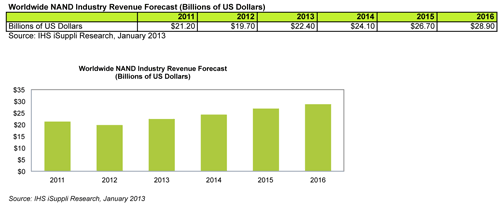El Segundo, Calif. (Feb. 5, 2013)—Global NAND flash memory market revenue fell 7 percent in 2012 as disappointing Ultrabook sales negated the impact of surging demand from Apple Inc. for its iPhone line, according to an IHS iSuppli Data Flash Market Tracker Report from information and analytics provider IHS (NYSE: IHS).
NAND industry revenue fell to $19.7 billion last year, down from $21.2 billion in 2011. Revenue, however, will pick up this year and rise to $22.4 billion after last year’s stumble, and then continue to expand during the next few years, as shown in the figure below.

“Because of its high-memory density, combined with high-volume shipments, Apple’s iPhone line in 2012 was the largest single consumer of NAND, helping to increase demand for the memory from the smartphone market,” said Michael Yang, senior principal analyst for memory & storage at IHS. “However, Ultrabook sales fell short of industry expectations, dragging down the overall NAND market for the year.”
iPhone bulks up on NAND
iPhones consumed 10.5 percent of the total NAND flash supply in 2012. In comparison, all other smartphones combined used 10.4 percent. The iPhone in 2012 had an average density of 24.5 gigabytes, a 19 percent increase in density loading compared to 2011. This represents the highest amount of embedded NAND flash among all smartphones.
Middle-of-the-road results for Ultrabooks
A major drag on the NAND industry was the disappointing sales of Ultrabooks, negatively impacting the flash memory prospects of cache solid state drives (SSD) used in the superthin computers. While Ultrabooks have had some success penetrating into the consumer computing experience, adoption overall has been underwhelming, and the incremental increase to demand has been significantly below expectations. And while SSDs achieved significant growth in 2012, the expansion was diminished by the poor results for Ultrabooks.
Windows 8 comes too late
Microsoft Corp. also didn’t help matters by deferring the launch of Windows 8 until Oct. 26, which left little time to generate interest among consumers and the corporate sector alike. As a result, PC shipments in the third quarter last year saw a substantial quarterly decline as consumers waited out the new operating system, and high inventories of older Windows 7-based PCs remained in the supply chain well into the fourth quarter.
NAND suppliers react
Such mishaps, along with overall muted demand, prompted the NAND industry to slow production midway through 2012. Suppliers took action to prevent what would have been a disastrous year for all, and a shrewd move to stabilize pricing in August ultimately led to a minor rally in October. Even so, the second half last year turned out to be weaker than expected despite solid results in the third quarter, blunting growth and resulting in the contraction of industry revenue by the end of last year.
NAND flash manufacturers will need to continue to tightly manage their supply for the first half of 2013, as the first six months of the year traditionally are the weak period for the industry. And with the market moving away from low-margin applications like flash cards and universal flash drives toward higher-value applications, the success of NAND flash players will be increasingly dependent on a smooth transition from acting solely as pure-play sellers to that of providing complete solutions, IHS iSuppli believes.
Three devices to prop up the NAND space
The fate of the NAND industry in the near and intermediate term rests on the support of three pillars of demand: smartphones, tablets and SSDs. Smartphones, for instance, historically provided important growth in NAND flash bit demand. And while growth is starting to slow when compared to the earlier boom years, the smartphone engine will not run out of steam anytime soon.
In comparison, tablets have only recently become a major driving force for NAND demand, with other tablet manufacturers and operating systems beginning to give Apple’s iPad some serious competition.
For their part, SSDs are still in their nascent stage despite making up a notable portion of NAND demand, as suppliers are still waiting for the tipping point when consumers fully embrace the new drives.
Moving forward, 2013 will mark the start of another expansion period for the industry. Robust growth is expected, balanced with technology advancements and production expansion. In particular, the second half of this year will be healthy, boosted by increased demand throughout the NAND portfolio.
Advertisement
Learn more about IHS iSuppli





